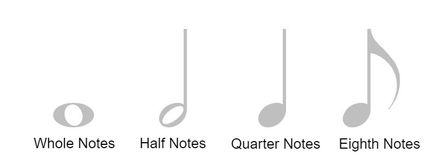How to Read Music
When we're first learning a new language, we have to break things down into the basics, and start from there.
Before we learn words, we begin with the alphabet, and the letters that we use to make up those words. Music is the exact same way.
Reading music requires us to be familiar with certain symbols, and memorize what they mean, and how they affect what we're playing.
The following are basic things that we simply have to know in order to read our music.
Before we learn words, we begin with the alphabet, and the letters that we use to make up those words. Music is the exact same way.
Reading music requires us to be familiar with certain symbols, and memorize what they mean, and how they affect what we're playing.
The following are basic things that we simply have to know in order to read our music.
1: Identifying Musical Notes:
Our musical notes are named after the first seven letters of our alphabet: A, B, C, D, E, F, and G. There is no H note.
As our notes ascend, they follow this order, and then repeat, over and over.
Ex: A - B - C - D - E - F - G (repeat) A - B - C - D - E - F - G (repeat) A - B - C - D - E - F - G
Our musical notes are named after the first seven letters of our alphabet: A, B, C, D, E, F, and G. There is no H note.
As our notes ascend, they follow this order, and then repeat, over and over.
Ex: A - B - C - D - E - F - G (repeat) A - B - C - D - E - F - G (repeat) A - B - C - D - E - F - G
They follow the same order as the white and black keys on a piano. The distance between any two coloured keys represents a musical half step. Moving a pitch up a half step results in a sharp note (#), and lowering it a half step results in flat note (b). On the piano, the black keys represent these sharps and flats.
You may have noticed that there are two places on the piano where there is no black key. This means that between E and F and B and C there are no sharps or flats.
We can tell which notes are which by reading them on something called the musical staff. This is the series of 5 horizontal lines that our notes are written on.
Notes appear either between these lines or directly on them. Here is an example of one of the first notes we start with on trumpet, "G", which is always written on the second line of the staff.
There are specific spots on the staff for every note. These spots always stay the same, and it's up to us to remember where they're found.
There are memory tricks we can use to learn these spots. The spaces on our staff spell out "Face" and for the lines try using the mnemonic "Every Good Boy Deserves Fudge".
There are memory tricks we can use to learn these spots. The spaces on our staff spell out "Face" and for the lines try using the mnemonic "Every Good Boy Deserves Fudge".
Click the button below to find an interactive lesson that teaches us more about the musical staff, and where to place each note on it.
2: Types of Notes:
Hopefully we now understand clearly what the staff is, and we're ready to learn about the different kinds of notes we'll be reading. We need to understand this before we can combine them to build our melodies. Below are the four most common note types used in our music:
Hopefully we now understand clearly what the staff is, and we're ready to learn about the different kinds of notes we'll be reading. We need to understand this before we can combine them to build our melodies. Below are the four most common note types used in our music:
Click the button below to learn more about the difference between these types of notes.
3: Time Signatures:
Our musical staff is separated into even chunks using vertical lines called bar lines. Each of these chunks is referred to as a measure.
We know how many notes fit into each measure because of our time signature. This is the two stacked numbers (it looks like a fraction) that we find at the start of the staff. The top number tells us how many beats (the rhythmic pulse) are in each measure, and the bottom number tells us, what note value that beat represents.
Our musical staff is separated into even chunks using vertical lines called bar lines. Each of these chunks is referred to as a measure.
We know how many notes fit into each measure because of our time signature. This is the two stacked numbers (it looks like a fraction) that we find at the start of the staff. The top number tells us how many beats (the rhythmic pulse) are in each measure, and the bottom number tells us, what note value that beat represents.
In the photo above we see our two most common time signatures. 4/4 and 3/4.
Click the button below to learn more about the different time signatures found in our music.
- 4/4: The top number tells us that there are 4 beats per bar. The bottom number tells us that we're using a quarter note to measure our beat.
- 3/4: The top number tells us that there are 3 beats per bar. The bottom number tells us that we're once again using a quarter note to measure our beat.
Click the button below to learn more about the different time signatures found in our music.





